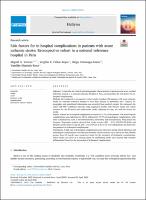| dc.contributor.author | Vences, Miguel A. | |
| dc.contributor.author | Failoc-Rojas, Virgilio E. | |
| dc.contributor.author | Urrunaga Pastor, Diego | |
| dc.contributor.author | Hurtado Roca, Yamilée | |
| dc.date.accessioned | 2023-05-30T14:09:07Z | |
| dc.date.available | 2023-05-30T14:09:07Z | |
| dc.date.issued | 2023-05-01 | |
| dc.identifier.citation | Heliyon. 2023; 9(5). | es_PE |
| dc.identifier.issn | 2405-8440 | |
| dc.identifier.uri | https://hdl.handle.net/20.500.12959/3754 | |
| dc.description.abstract | Objective: To describe the clinical and demographic characteristics of patients with acute cerebral
infarction treated at a national reference hospital in Peru and determine the risk factors for inhospital complications.
Methods: We conducted a retrospective cohort study including 192 patients with acute ischemic
stroke in a national reference hospital in Peru from January to September 2021. Clinical, demographic and paraclinical information was recorded from medical records. We estimated risk
ratios and 95% confidence intervals using regression models with Poisson family and robust
variance for the bivariate and multivariate model, adjusting for age, sex and risk factors for
stroke.
Results: At least one in-hospital complication occurred in 32.3% of the patients. The most frequent
complications were infectious in 22.4%, followed by 17.7% of neurological complications, with
other complications, such as thromboembolism, immobility and miscellaneous, being much less
frequent. Regression analysis showed that stroke severity (RR = 1.76; 95%CI:1.09–2.86) and
albumin greater than 3.5 mg/dL (RR = 0.53; 95%CI: 0.36–0.79) were independent risk factors for
the presence of in-hospital complications.
Conclusions: A high rate of in-hospital complications were observed, among which infectious and
neurological complications were the most frequent. Stroke severity was a risk factor and albumin
greater than 3.5 mg/dL was a protective factor for the incidence of in-hospital complications.
These results can serve as a starting point for establishing stroke care systems that consider
differentiated flows for the prevention of in-hospital complications. | es_PE |
| dc.format | application/pdf | es_PE |
| dc.language.iso | eng | es_PE |
| dc.publisher | Cell Press | es_PE |
| dc.relation.uri | https://www.sciencedirect.com/science/article/pii/S2405844023030177 | es_PE |
| dc.rights | info:eu-repo/semantics/openAccess | es_PE |
| dc.rights.uri | https://creativecommons.org/licenses/by-nc-sa/4.0/ | es_PE |
| dc.subject | Stroke | es_PE |
| dc.subject | Acute | es_PE |
| dc.subject | Ischemic stroke | es_PE |
| dc.subject | Complications | es_PE |
| dc.subject | Risk factors | es_PE |
| dc.title | Risk factors for in-hospital complications in patients with acute ischemic stroke: Retrospective cohort in a national reference hospital in Peru | es_PE |
| dc.type | info:eu-repo/semantics/article | es_PE |
| dc.subject.ocde | https://purl.org/pe-repo/ocde/ford#3.02.04 | es_PE |
| dc.identifier.doi | https://doi.org/10.1016/j.heliyon.2023.e15810 | |






